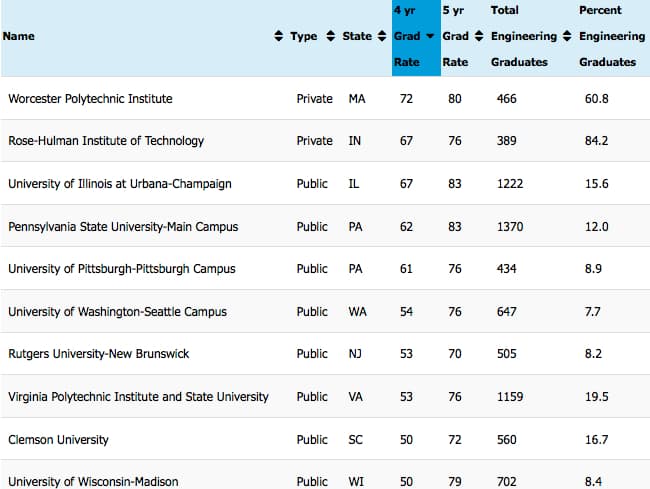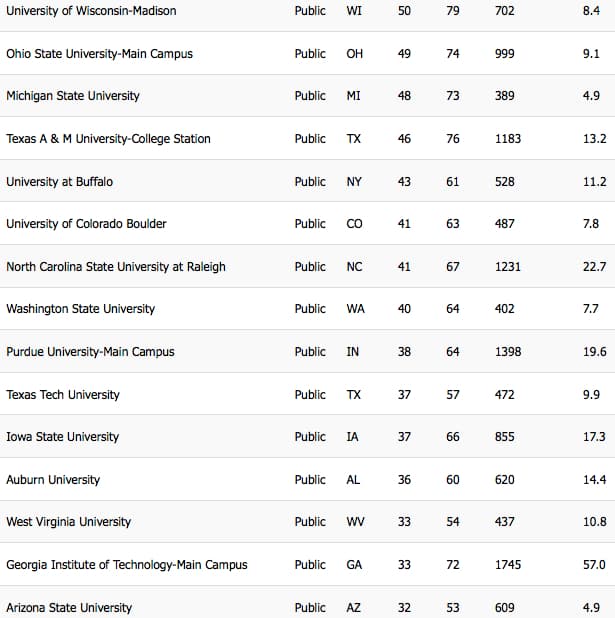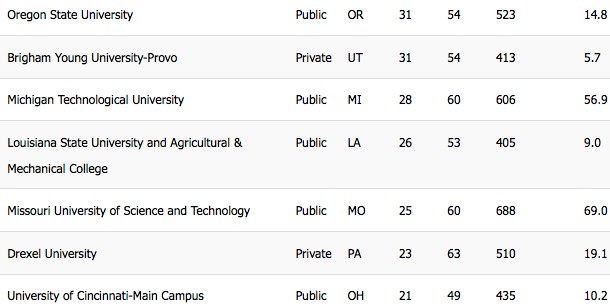
We’ve been talking about engineering schools in a couple of recent posts, which is why I wanted to share an engineering list that my friend Michelle Kretzschmar at Do It Yourself College Rankings recently put together for her website.
Michelle, who is a data whiz, pulled together a list of universities that educate the largest number of engineer students where the admission requirements are too rigorous. ((MIT isn’t on this list.)
Because Michelle was looking for schools with the greatest concentration of engineering students almost all of the institutions on the list are public. The public schools that made the list had to have a five-year grad rate of at least 49 percent and an acceptance rate of at least 49%. The private schools had to have a four-year grad rate of at least 49%.
I suspect that most families assume that their children are going to graduate in four years, but most students don’t. The four-year grad rate for public colleges and universities is 31% and 52% for private institutions. Engineering students are more likely to have to remain in school five years to obtain their bachelors degree.
As you can see from Michelle’s chart, the four-year grad rates are best at two of the three private schools on the list. The four-year grad rates vary dramatically with the University of Illinois (67%) at the top and the University of Cincinnati (21%) at the bottom.




I think you are asking the wrong question. My grandson is looking at several engineering schools including Ohio State (Go Bucks) and University of Cincinnati. Their numbers in your chart are very misleading. These schools have FIVE year programs which include a year coop. The coop pays SERIOUS money and prepares the students for employment upon graduation. UC claims 98+% employment. (UC even has a nerd class to help kids like my nerdy grandson learn how to interview.:>)
My daughter and son-in-law are very concerned about cost particularly because they have two boys starting school at once. We have run the numbers and both of these schools work financially. On the other hand University of Dayton (which also has a coop program) is not a price performer.
Suggest you check out coop options and employment rates and worry less about 4 vs 5 years.
Hi Tom,
I am very skeptical of job placement figures for all schools – coops or not. These are almost always self-reported figures that are misleading. The percentage of students who complete the job placement surveys are usually low and it’s going to be the ones who have jobs that complete them. Beware of rosy job placement rates for any school. Two schools that do a good job of tracking down graduates and posting accurate numbers are St. Olaf College and Wake Forest University.
Lynn O’Shaughnessy
Point taken on job placement figures. As we get in closer I’ll be sure to follow up on this. Being in Cincinnati that will be easy to do. I know any number of alumni including my younger son who has an E.E. degree.
But you are missing my main point. The chart above is inadequate and misleading. It doesn’t distinguish between schools with four year programs and schools with five year programs. The four year graduation rate at schools where most students enroll in a five year program is irrelevant. UC provides a four year option but few students are interested. The same is true at Ohio State now. (In the good old days when I was an undergraduate at Ohio State-fifty years ago-engineering was a four year curriculum.)
This is only meant as constructive criticism. I hope your friend, Michelle, will refine her chart. I would think that the key variable is percentage of students graduating ON SCHEDULE not students graduating in four years.
(Anticipating the next response–the cost of the UC and Ohio State degrees are very competitive because of the generous coop arrangements.)
My son is at WPI and loves it. Being surrounded by other kids fascinated by science and technology was just what he was looking for. The key to the graduation rate is the unique schedule in which students take 3 classes for each of the four 7-week terms each year. Thus, there are 6 classes in the fall and 6 in the spring, but since you are only taking three classes at a time, it’s manageable. All you have to do to graduate on time is make a C or better in all your classes, or make up any classes you fail. And if you do fail or make a D in a class, it does not appear on the transcript–they call it “no record.”
As a STEM grad of one of the schools on the list (BTW, making it out four years nearly killed me), I thought I’d pass along some things for parents and students who may not have been through a STEM program in the past.
a. STEM courses are hard. While that’s a statement of the obvious, it also means that students are likely to drop a class and have to retake it. Otherwise they stand the chance of ruining several grades by the amount of time that class requires.
b. There are a lot of prerequisite courses. Unfortunately, if all the stars and courses don’t line up, you may have to wait a semester or a year for that prereq. And, if you drop that prereq (see “a” above) then this can easily domino into a whole semester or year delay on graduation.
c. There are more than a few professors who, when they say “look at your neighbors; one of you won’t be here at the end of the semester” really mean it. Which goes back to “b” above.
d. Besides all the STEM courses, you still have a whole program’s worth of liberal arts courses to take. You almost wind up taking a double major in terms of the total course count.
e. This is the payoff. When you get past the initial weed out courses, you become one of us. You’re on your way to being an engineer and now we will treat you like a colleague rather than a student. You get more research and more direct one on one time with professors. More lab time. And, more work.
I don’t mean to discourage anyone, but just to let people know what they are getting into. But once you hit item “e” STEM is like a small college or house within the university. When you are arguing one vs one — doing combat physics — with a prof in the lounge and you realize everyone there is watching you, not as a student, but as a peer, the feeling can’t be described.
Are these 4-year graduation rates for the general student population, or for engineering students specifically?
Graduation rates are important but there are varying factors driving these numbers. For example, we recently attended an info session at Drexel, whose 4-year graduation rate in the chart above looks dismal. But that is because a huge number of students choose the 5-year program which includes 3 co-op experiences. They claim that close to 100% of their engineering grads find a job placement shortly after graduation, many from their co-op employers. While Drexel is an expensive school, the offset of having work experience in your field during your undergrad years is something worth considering.
I notice my undergrad alma mater Drexel on this list near the bottom. Drexel (rightfully) gets criticized for being expensive and frugal with financial aid, but I think it’s unfair to paint it as inefficient at graduating students on time.
Drexel’s engineering school requires participation in co-op employment, and most students elect to complete 18+ months of employment. As a result, the intended program of studies is actually five years, not four. Furthermore, for engineering students, paid co-ops can be fairly lucrative, which does offset some of the sting of the extra year tuition — to say nothing of the career-building benefits.
I think if the data existed to compare graduation dates with students expectations, Drexel would do much better in comparison with its peers on this list.
“I suspect that most families assume that their children are going to graduate in four years, but most students don’t.” – this is such an important thing to remember with today’s high college costs. Thank you for posting this.
Lynn,
The Drexel four year rate is abnormally low because of their Co-op Program adds a year to the program (not that Drexel is a favorite of yours anyway 🙂 .)
I am curious – did Rochester Institute of Technology come up at all? This is another school with a low 4 year graduation rate partly due to a co-op embedded in the program.